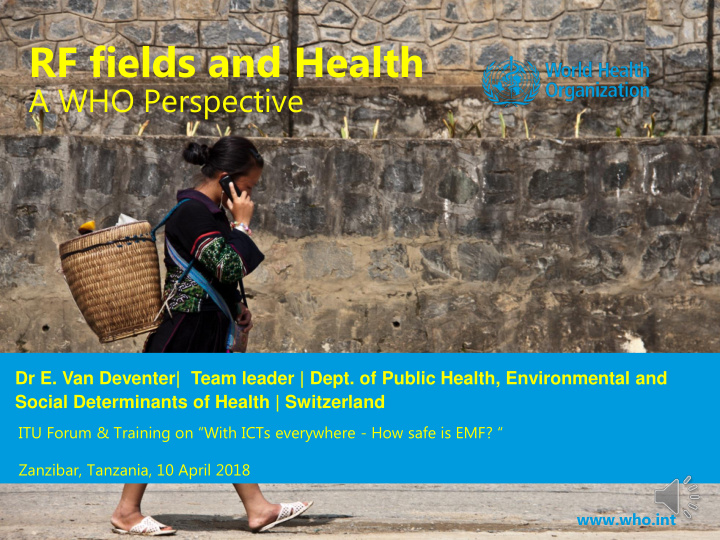



RF fields and Health A WHO Perspective Dr E. Van Deventer| Team leader | Dept. of Public Health, Environmental and Social Determinants of Health | Switzerland ITU Forum & Training on “With ICTs everywhere - How safe is EMF? “ Zanzibar, Tanzania, 10 April 2018 www.who.int
OUTLINE Introduction Assessing the health risks Discussion
World Health Organization Function : act as the UN directing and coordinating authority on international health work Objective : "the attainment by all peoples of the highest possible level of health"
HEALTH a state of COMPLETE physical, mental and social well-being and not merely the ABSENCE of disease or infirmity" (Constitution, 1948)
The Present EMF Context • Increasing EMF human exposure due to electricity demand, medical technologies and wireless devices • Concern from the public
Applications using radiofrequency fields (100 kHz – 300 GHz) Navigation/Radar Wi-Fi Commercial Telecommunications Vehicular technologies Broadcasting Residential sources
Applications using radiofrequency fields (100 kHz – 300 GHz) http://www.satprnews.com/2017/09/11/global-5g-technology-and-solutions-for-iot-market-forecasts-to-2022-and-analysis/
WHO International EMF Project • Established in 1996 Coordinated by WHO HQ • • A multinational, multidisciplinary effort to create and disseminate information on human health risk from EMF • Membership • Open to any WHO Member State government department or representatives of national institutions concerned with radiation protection • Over 60 national authorities are currently involved in the Project
Do EMFs pose a heath risk? Risk Assessment The Evidence Risk Perception Risk Management The Public Concern The Policies
OUTLINE Introduction Assessing the health risk
The Present Scientific Knowledge Large and increasingly sophisticated database • Known mechanisms • International exposure guidelines based on • established health effects Scientific uncertainty •
What do we know? 100 kHz 300 MHz 10 GHz Frequency
What do we know? Mechanisms of interaction 100 kHz 300 MHz 10 GHz Frequency Induced currents Induced currents and heating Heating Surface heating (skin) Non-thermal effects??
What do we know? Mechanisms of interaction 100 kHz 300 MHz 10 GHz Frequency Below 1 GHz 1 – 6 GHz Above 6 GHz and most likely above 24 GHz ?
Research Balance of studies needed http:// www.niehs.nih.gov/emfrapid/booklet/emf2002.pdf
Laboratory Studies Cellular studies • Genotoxicity • Gene expression Animal studies • Cancer • Behaviour • BBB • Skin Human studies • Sleep • EEG • Hormones • EHS
dose near-field dose far-field dose From Martin Röösli
Epidemiological studies Studies on mobile phones Tumours in head and neck • Glioma, meningioma, acoustic neuroma, parotid gland Numerous studies on the use of mobile phones • Published: USA, Nordic countries, INTERPHONE, CEFALO • Ongoing: MOBI-Kids, COSMOS, GERoNiMO , …
E pidemiological studies Wi-Fi Base stations and wireless networks Some studies have been performed • Well-being and performance • Cancer Personal exposure assessment GSM 3GWi-Fi GSM Kenneth R. Foster, Radiofrequency exposure from wireless LANs utilizing WI-FI technology . Health Phys. 92(3):280 – 289; 2007
Health Risk Assessment Problem Formulation Hazard Identification Review key research to identify any potential health problems that an agent can cause Exposure Assessment Exposure-Response Determine the amount, Assessment duration and pattern of Estimate how much of the exposure to the agent agent it would take to cause varying degrees of health effects that could lead to illnesses Risk Characterization Assess the risk for the agent to cause cancer or RF fields classified as other illnesses in the " possibly carcinogenic to humans" general population (Group 2B)
Health Risk Assessment (cont'd) Problem Formulation Hazard Identification Review key research to identify any potential health problems that an agent can cause All studied Exposure Assessment outcomes Exposure-Response Radiofrequency Fields Determine the amount, Assessment duration and pattern of Estimate how much of the exposure to the agent agent it would take to cause varying degrees of health effects that could lead to illnesses Risk Characterization Assess the risk for the agent to cause cancer or other illnesses in the general population
Discussion “ 5G, EMF & Health ” Is it too early to discuss this point? •
Challenges • Exposure assessment https://www.gsma.com/publicpolicy/wp-content/uploads/2017/10/5g_iot_web_FINAL.pdf • Compliance assessment • Epidemiological studies
Discussion “ 5G, EMF & Health ” Is it too early to discuss this point? • • Is exposure to radiofrequency fields from wireless technologies the main health concern? HEALTH a state of COMPLETE physical, mental and social well-being and not merely the ABSENCE of disease or infirmity" (Constitution, 1948)
Discussion “ 5G, EMF & Health ” (cont’d )
Challenges to governments…. • Rapidly evolving RF technologies • Launched on the market before health evaluation • Disparities in risk management measures and regulations around the world • Concern from the public
Conclusions • Need for clear roles and responsibilities in government on this topic • Need for adoption and compliance of health-based standards • Need for a public information program and dialogue with stakeholders • Need for promoting research to reduce uncertainty We are a "global village"
Thank you. Dr E. Van Deventer WHO Team leader, Radiation Programme 20, Avenue Appia Dept of Public Health, Environmental and Social 1211 Geneva Determinants of Health Switzerland www.who.int
Recommend
More recommend